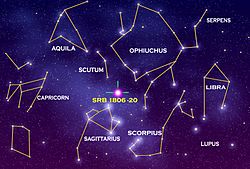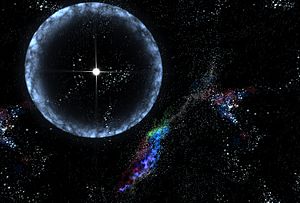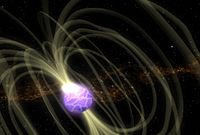SGR 1806−20 facts for kids
| Observation data Epoch J2000 Equinox J2000 |
|
|---|---|
| Constellation | Sagittarius |
| Right ascension | 18h 08m 39.32s |
| Declination | −20° 24' 39.5"' |
| Apparent magnitude (V) | totally obscured |
| Astrometry | |
| Distance | 42,000 ly (13,000 pc) |
| Details | |
| Rotation | 7.55592 s |
| Other designations | |
| Database references | |
| SIMBAD | data |
SGR 1806−20 is a special type of neutron star called a magnetar. It has an incredibly strong magnetic field. Scientists found it in 1979 and learned it sends out bursts of gamma rays.
This magnetar is about 42,000 light-years away from Earth. It's located on the far side of our Milky Way galaxy. You can find it in the constellation called Sagittarius. SGR 1806−20 is very small, only about 20 kilometers (12 miles) wide. It spins very fast, completing one rotation every 7.5 seconds.
As of 2016, SGR 1806−20 had the strongest magnetic field ever seen. It was over a thousand trillion times stronger than Earth's magnetic field!
What is a Magnetar?
A magnetar is a kind of neutron star. Neutron stars are what's left after a very big star explodes. They are super dense and have powerful gravity. Magnetars are even more special because their magnetic fields are extremely strong. These fields can be a thousand times stronger than those of other neutron stars.
The Giant Explosion
On December 27, 2004, a huge burst of radiation reached Earth. This burst came from SGR 1806−20. It was caused by a "starquake" on the magnetar's surface. A starquake is like an earthquake, but on a star. The radiation had traveled for 50,000 years to get to us!
This burst was the brightest event ever seen from outside our Solar System. In just one-tenth of a second, the magnetar released more energy than our Sun produces in 150,000 years! It was the biggest explosion observed in our galaxy since the supernova seen by Johannes Kepler in 1604.
When the gamma rays from this explosion hit Earth, they affected our ionosphere. The ionosphere is a part of Earth's atmosphere. The gamma rays made it expand for a short time.
If a similar blast happened closer to Earth, about 10 light-years away, it could cause big problems. It might harm our atmosphere and lead to many living things disappearing.
Where is SGR 1806−20 Located?
SGR 1806−20 is found in a gas cloud called G10.0-0.3. It's also part of a group of stars known as the 1806-20 cluster. This cluster is inside a much larger area called W31. W31 is one of the biggest regions in the Milky Way where new stars are forming.
The 1806-20 cluster has some very unusual stars. These include special Wolf–Rayet stars and two huge, bright stars called blue hypergiants. It also contains LBV 1806-20, which is one of the brightest and most massive stars in our galaxy.
See also
 In Spanish: SGR 1806-20 para niños
In Spanish: SGR 1806-20 para niños
- LBV 1806-20 – a very bright and massive star




